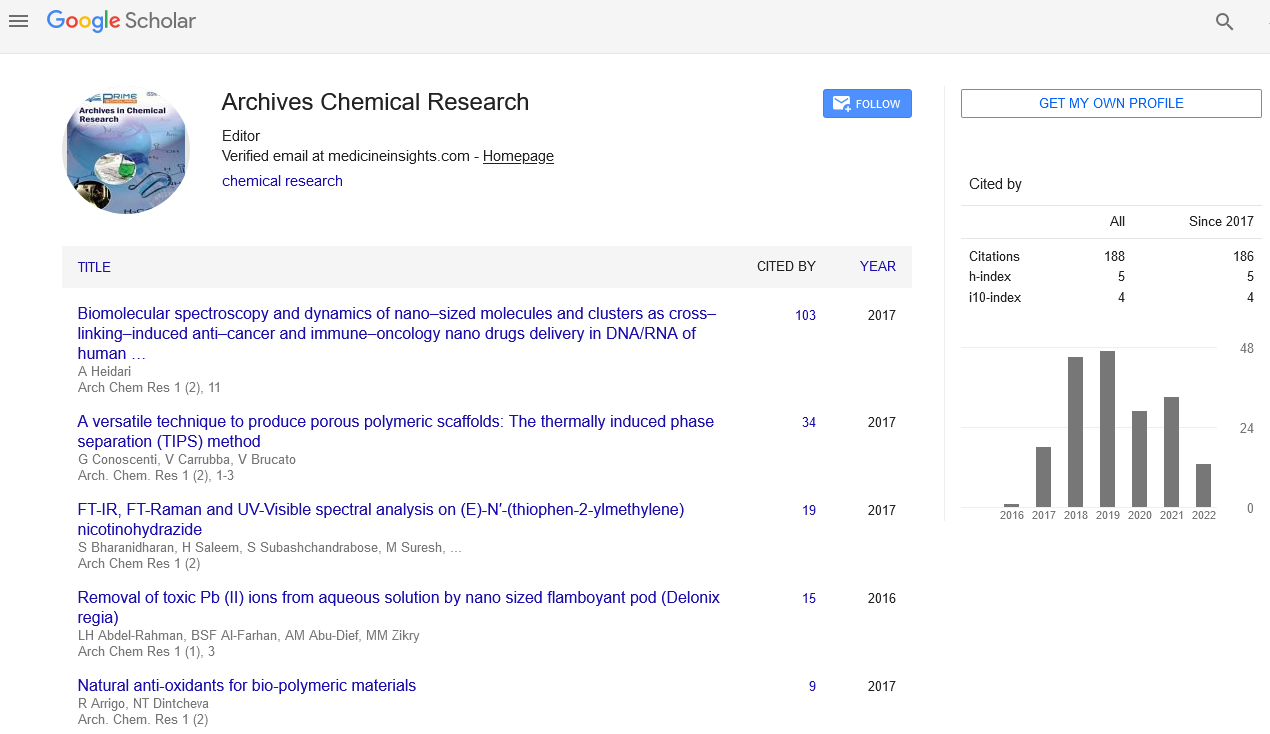Short Communication - (2024) Volume 8, Issue 1
Unveiling the Precision and Power of Analytical Chemistry
Joseph Miller*
Department of Chemical Research, Cornell University, USA
*Correspondence:
Joseph Miller,
Department of Chemical Research, Cornell University,
USA,
Email:
Received: 28-Feb-2024, Manuscript No. IPACRH-24-19475;
Editor assigned: 01-Mar-2024, Pre QC No. IPACRH-24-19475 (PQ);
Reviewed: 15-Mar-2024, QC No. IPACRH-24-19475;
Revised: 20-Mar-2024, Manuscript No. IPACRH-24-19475 (R);
Published:
27-Mar-2024, DOI: 10.35841/2572-4657.8.1.02
Introduction
In the vast landscape of chemistry, there exists a discipline
that serves as its investigative backbone, offering insights
into the composition, structure, and properties of matter
with unparalleled precision. This discipline is none other than
analytical chemistry, a field dedicated to the development and
application of methods for the qualitative and quantitative
analysis of substances. In this article, we delve into the
fascinating realm of analytical chemistry, exploring its
principles, techniques, and diverse applications across various
sectors. At its essence, analytical chemistry is concerned with
answering 2 fundamental questions what is it and How much is
there questions drive the development of analytical methods
that enable scientists to identify and quantify the constituents
of complex samples, ranging from environmental pollutants
and pharmaceuticals to food additives and biomolecules.
Analytical chemists employ a wide array of techniques, each
tailored to specific analytical challenges and sample types. One
of the cornerstones of analytical chemistry is spectroscopy,
a technique that involves the interaction of matter with
electromagnetic radiation [1,2].
Description
Chromatography stands as another pillar of analytical
chemistry, offering powerful separation capabilities for complex
mixtures. Gas Chromatography, Liquid Chromatography, and
Capillary Electrophoresis are among the most widely used
chromatographic techniques, each offering unique advantages
in terms of selectivity, sensitivity, and speed. By exploiting
differences in the interaction of analyses with stationary and
mobile phases, chromatography enables the isolation and
quantification of individual components within a mixture.
In addition to spectroscopy and chromatography, analytical
chemistry encompasses a diverse range of techniques,
including electrochemical methods, immunoassays, titrations,
and surface analysis techniques. Each method brings its own set
of strengths and limitations to the analytical toolkit, allowing
chemists to tackle a wide range of analytical challenges with
precision and accuracy. The applications of analytical chemistry
span a multitude of industries and fields, playing a crucial role
in research, quality control, environmental monitoring, forensic
analysis, and healthcare. In the pharmaceutical industry,
analytical chemistry is indispensable for drug development
and quality assurance, ensuring the safety, efficacy, and purity
of pharmaceutical products. Analytical methods are used to
characterize raw materials, monitor chemical reactions, and
assess the stability of drug formulations throughout their
lifecycle. Similarly, in environmental monitoring, analytical
chemistry plays a vital role in detecting and quantifying
pollutants in air, water, soil, and food samples. Analytical
methods such as Gas Chromatography-mass Spectrometry
(GC-MS) and High-Performance Liquid Chromatography enable
the identification and quantification of trace contaminants,
facilitating regulatory compliance and environmental
protection efforts [3,4].
Conclusion
Moreover, analytical chemistry finds applications in forensic
science, where it aids in the analysis of evidence such as drugs,
explosives, and biological samples. Techniques such as DNA
analysis, fingerprinting, and chemical profiling play a crucial role
in criminal investigations, helping to establish links between
suspects, victims, and crime scenes. In conclusion, analytical
chemistry serves as a cornerstone of scientific inquiry and
technological advancement, providing the tools and methods
necessary to unravel the mysteries of matter. With its precision,
versatility, and wide-ranging applications, analytical chemistry
continues to drive innovation across diverse sectors, shaping
our understanding of the world and addressing complex
challenges in fields ranging from healthcare and environmental
science to forensics and beyond.
Acknowledgement
None.
Conflict Of Interest
The author’s declared that they have no conflict of interest.
References
- Debie E, Kuppens T, Vandyck K, Eycken J, Veken B, et al. (2006) Vibrational circular dichroism dft study on bicyclo [3.3.0] octane derivatives. Tetrahedron: Asymmetry. 17:3203-3218.
[Crossref] [Google Scholar]
- Shen J, Zhu C, Reiling S, Vaz R (2010) A novel computational method for comparing vibrational circular dichroism spectra. Spectrochim Acta A Mol Biomol Spectrosc. 76(3-4):418-22.
[Crossref] [Google Scholar] [PubMed]
- Klaschka U, Tehrani M, Faraji H, Husain S, Azar P (2016) Are natural compounds used in personal care products toxic for the aquatic environment. Sustain Chem Pharm. 1183:122973.
[Crossref] [Google Scholar] [PubMed]
- Liu L, Yang Y, Liu P, Tan W (2014) The influence of air content in water on ultrasonic cavitation field. Ultrason Sonochem. 21:566-571.
[Crossref] [Google Scholar] [PubMed]
Citation: Miller J (2024) Unveiling the Precision and Power of Analytical Chemistry. Arch Chem Res. 8:02.
Copyright: © 2024 Miller J. This is an open-access article distributed under the terms of the Creative Commons Attribution License, which permits unrestricted use, distribution, and reproduction in any medium, provided the original author and source are credited.

